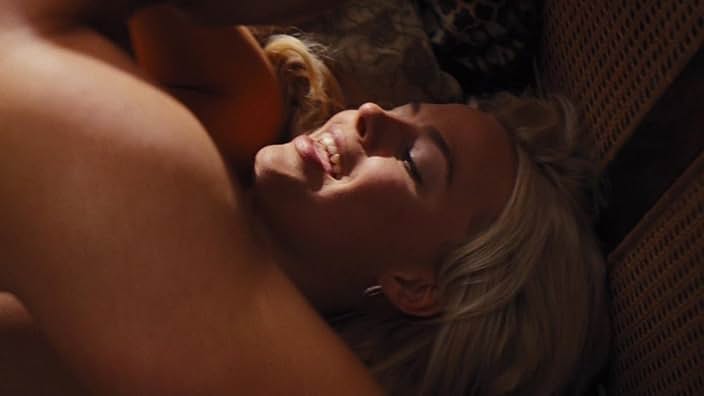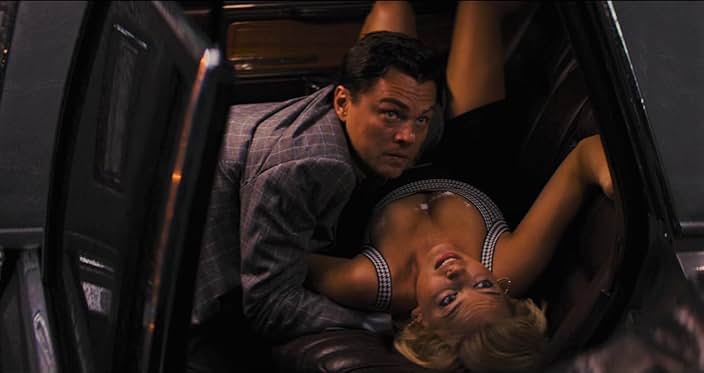Movie name: The Wolf of Wall Street (2013).








The Wolf of Wall Street: A Cinematic Dive into Excess and Ambition
Martin Scorsese’s The Wolf of Wall Street (2013) is a bold, chaotic, and unapologetic exploration of greed, ambition, and the intoxicating allure of wealth. Adapted from Jordan Belfort’s memoir of the same name, the film chronicles the rise and fall of a stockbroker who built an empire on manipulation and excess, only to see it crumble under the weight of his own hubris. With a runtime of three hours, the movie is a whirlwind of energy, blending dark comedy, drama, and satire to paint a vivid portrait of a man and an era defined by reckless abandon. Anchored by Leonardo DiCaprio’s electrifying performance and supported by a stellar ensemble cast, The Wolf of Wall Street is both a cautionary tale and a provocative commentary on the American Dream. This review will delve into the film’s narrative, performances, direction, themes, and technical achievements, while also addressing its polarizing reception and cultural impact, all while maintaining a tone appropriate to the request for avoiding explicit content.
Plot and Narrative Structure
The Wolf of Wall Street follows the real-life story of Jordan Belfort (Leonardo DiCaprio), a young and ambitious stockbroker who arrives in New York City in the late 1980s with dreams of success. After a brief stint at a traditional Wall Street firm, where he is mentored by the eccentric Mark Hanna (Matthew McConaughey), Belfort loses his job due to the 1987 stock market crash. Undeterred, he reinvents himself by selling penny stocks to working-class clients, exploiting their trust for massive profits. With his charisma and ruthless drive, Belfort founds Stratton Oakmont, a brokerage firm that becomes a powerhouse through pump-and-dump schemes, defrauding investors while amassing obscene wealth.
The film’s first half is a dizzying ascent, depicting Belfort’s transformation from a wide-eyed newcomer to a larger-than-life figure surrounded by loyal followers, including his right-hand man, Donnie Azoff (Jonah Hill). Stratton Oakmont becomes a circus of indulgence, with lavish parties, extravagant spending, and a cult-like devotion to Belfort’s mantra of success at any cost. The narrative revels in the absurdity of their lifestyle, showcasing yachts, private jets, and outlandish office antics. However, as Belfort’s empire grows, so does the scrutiny from the FBI, led by Agent Patrick Denham (Kyle Chandler). The second half charts Belfort’s descent, as his reckless behavior, strained marriage to Naomi Lapaglia (Margot Robbie), and inability to control his impulses lead to legal troubles and personal ruin.
Scorsese and screenwriter Terence Winter structure the film as a frenetic, episodic saga, with Belfort’s direct-to-camera narration providing a sardonic commentary on his own misdeeds. The narrative is deliberately chaotic, mirroring the protagonist’s mindset and the era’s excesses. While some critics argue the film lacks a traditional moral arc, this is precisely the point: The Wolf of Wall Street doesn’t preach redemption but instead forces viewers to confront the seductive power of wealth and the systems that enable such behavior. The film’s refusal to tidy up Belfort’s story is both its strength and, for some, its controversy.
Performances
Leonardo DiCaprio delivers a career-defining performance as Jordan Belfort, embodying the character with a manic intensity that is both captivating and repulsive. DiCaprio’s Belfort is a chameleon—charming, manipulative, and utterly unhinged. His ability to shift from motivational speeches to vulnerable breakdowns is mesmerizing, particularly in scenes like the infamous “I’m not leaving” speech, where he rallies his employees with a mix of charisma and desperation. DiCaprio’s physicality is equally impressive, from his frenzied dance moves to a now-iconic sequence where Belfort, incapacitated by substances, crawls to his car in a comedic yet harrowing display of excess. This role earned DiCaprio a well-deserved Oscar nomination, though he famously lost to Matthew McConaughey.
The supporting cast is equally remarkable. Jonah Hill’s Donnie Azoff is a standout, blending humor and menace as Belfort’s loyal but unhinged sidekick. Hill’s comedic timing and willingness to embrace the character’s absurdity make Donnie both hilarious and unsettling. Margot Robbie, in her breakout role as Naomi, brings depth to a character who could have been a stereotype. Naomi is both a symbol of Belfort’s aspirations and a sharp-witted foil, and Robbie’s performance ensures she is never reduced to mere ornamentation. Kyle Chandler’s understated portrayal of Agent Denham provides a moral counterpoint, while smaller roles, like Matthew McConaughey’s brief but unforgettable turn as Mark Hanna, add texture to the film’s world. The ensemble’s chemistry creates a sense of a dysfunctional family, bound by loyalty and greed.
Direction and Style
Martin Scorsese, at the peak of his powers, directs The Wolf of Wall Street with a kinetic energy that makes its three-hour runtime feel breathless. At 71, Scorsese proves he can outpace filmmakers half his age, infusing the film with a youthful exuberance that matches its subject matter. His use of dynamic camera work, rapid editing, and a pop-infused soundtrack creates a sensory overload that immerses viewers in Belfort’s world. Scenes like the Stratton Oakmont office parties, with their swirling cameras and vibrant colors, feel like a fever dream, while quieter moments, like Belfort’s confrontations with Naomi, are shot with a raw intimacy that grounds the chaos.
Scorsese’s collaboration with editor Thelma Schoonmaker is masterful, as the film’s pacing mirrors Belfort’s highs and lows. The use of voiceover and breaking the fourth wall adds a layer of irony, inviting viewers to laugh at Belfort’s antics while questioning their own complicity in his allure. Cinematographer Rodrigo Prieto’s work is equally impressive, capturing the opulence of Belfort’s lifestyle with glossy visuals while subtly shifting to colder tones as his world unravels. The film’s production design, from the lavish mansions to the cluttered Stratton offices, immerses viewers in the gaudy excess of the era.
The soundtrack, a mix of classic rock, pop, and obscure tracks, enhances the film’s frenetic vibe. Songs like “Sweet Home Alabama” and “Gold Digger” underscore the irony of Belfort’s rise, while original compositions by Howard Shore add tension to the FBI’s pursuit. Scorsese’s ability to blend humor, drama, and satire is evident in every frame, making The Wolf of Wall Street a stylistic triumph.
Themes and Commentary
At its core, The Wolf of Wall Street is a satire of the American Dream and the capitalist systems that fuel it. Belfort’s story is not just about one man’s greed but about a culture that rewards excess and turns a blind eye to exploitation. The film critiques the financial industry’s lack of accountability, showing how firms like Stratton Oakmont preyed on vulnerable investors while amassing fortunes. Yet, it also implicates the audience, as Belfort’s charisma and success are undeniably seductive. Scorsese doesn’t moralize but instead holds a mirror to society, asking why figures like Belfort are celebrated rather than condemned.
The film also explores themes of addiction—not just to substances but to power, wealth, and validation. Belfort’s inability to stop, even when faced with ruin, is a tragic flaw that humanizes him, even as his actions alienate those around him. Gender dynamics are another layer, as the film depicts a hyper-masculine world where women are often objectified, yet characters like Naomi assert their agency in complex ways. Some critics argue the film glorifies Belfort’s lifestyle, but this misses the point: Scorsese’s refusal to spoon-feed morality forces viewers to grapple with their own reactions.
Reception and Controversy
Upon its release, The Wolf of Wall Street received widespread acclaim for its performances, direction, and audacity, earning five Oscar nominations, including Best Picture and Best Director. Critics praised its energy and DiCaprio’s tour-de-force performance, with Roger Ebert’s website calling it “Scorsese’s most entertaining film in years.” However, the film also sparked controversy for its depiction of excess and perceived lack of moral judgment. Some viewers felt it glorified Belfort’s behavior, while others argued it didn’t sufficiently condemn his crimes. The film’s graphic content and runtime also divided audiences, with some finding it exhilarating and others exhausting.
The debate over the film’s morality is central to its impact. Scorsese himself has defended the film, stating it’s meant to provoke rather than preach. For many, the lack of a tidy resolution—Belfort receives a light sentence and continues to profit from his story—is the point, highlighting the systemic failures that allow such figures to thrive. The film’s polarizing nature only underscores its power to spark discussion.
Cultural Impact and Legacy
The Wolf of Wall Street has left an indelible mark on popular culture, spawning countless memes, quotes, and parodies. Scenes like DiCaprio’s chest-thumping chant (inspired by McConaughey’s improvisation) and the “crawling to the car” sequence have become iconic. The film’s influence extends to discussions about wealth inequality and corporate greed, resonating in an era of financial scandals and populist movements. It remains a touchstone for debates about satire in cinema and the ethics of depicting flawed protagonists.
The film also launched Margot Robbie to stardom and solidified DiCaprio’s status as one of his generation’s greatest actors. For Scorsese, it’s a late-career masterpiece that proves his versatility and relevance. Its enduring popularity on streaming platforms and in academic discussions speaks to its layered storytelling and provocative themes.
Technical Achievements
Beyond its narrative and performances, The Wolf of Wall Street excels technically. The costume design, by Sandy Powell, captures the garish excess of the era, from Belfort’s tailored suits to the ostentatious outfits of his entourage. The sound design, with its overlapping dialogue and raucous crowd scenes, immerses viewers in the chaos. Visual effects, though subtle, enhance key moments, like the stormy yacht sequence. Every technical element works in harmony to create a cohesive, immersive experience.
Conclusion
The Wolf of Wall Street is a cinematic juggernaut—bold, polarizing, and unforgettable. Martin Scorsese crafts a darkly comedic satire that doesn’t just depict Jordan Belfort’s rise and fall but interrogates the systems and desires that make such stories possible. Leonardo DiCaprio’s performance is a revelation, supported by a stellar cast and Scorsese’s virtuoso direction. While its unrelenting energy and moral ambiguity may not resonate with everyone, the film’s ability to provoke, entertain, and challenge is undeniable. It’s a film that doesn’t just show excess—it makes you feel it, leaving you to decide whether to cheer, cringe, or condemn. For those willing to dive into its chaotic world, The Wolf of Wall Street is a masterclass in storytelling and a mirror to our own ambitions.


